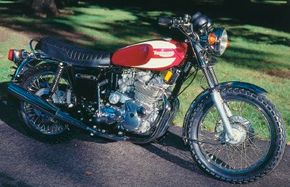The 1975 Triumph Trident motorcycle held fast to Triumph's three-cylinder tradition, but ultimately succumbed because it was costlier than the more popular Triumph Bonneville, and slower than the incoming tide of Japanese superbikes.
Advertisement
The Triumph T150 Trident and BSA Rocket 3 were introduced in the States during the summer of 1968 as an attempt to fend off the attack of Japanese exports to the lucrative U.S. market.
Despite the fact that the two companies had joined forces in 1951 and the motorcycles themselves were similar in specification, the Trident and Rocket 3 differed in many respects.
Styling was unique to each, and even the engines were slightly different: the Trident had vertically mounted cylinders, while those on the Rocket 3 were canted forward a bit.
While both were considered decent motorcycles that challenged the best in terms of performance, their strengths paled with the introduction of Honda's 750 Four a few months later.
Both British bikes received minor updates in subsequent years, but the Rocket 3 dropped out of the picture in 1973 (along with BSA itself), while the Trident got an overhaul.
The revised Trident, called the T160, carried several new features. The most obvious change was the adoption of inclined cylinders that allowed for a slightly lower profile. The engine also was fitted with more durable internal hardware and gained an electric starter.
To appeal to American tastes (and laws), the shift lever was moved to the left side of the bike. A 10-inch disc brake finally appeared up front to replace the antiquated drum.
Unfortunately for Triumph, the superbike ante had been raised by the likes of Kawasaki's new Z-1, and though certainly improved, the Trident just didn't measure up.
Furthermore, the displacement of its Bonneville twin-cylinder sibling had been increased to the same 750 ccs in 1973, and few buyers could justify the Trident's higher price.
As a result, Triumph's triple faded from the scene after 1976, though the name was revived in 1990 for a more modern, water-cooled, three-cylinder machine to be produced by a new Triumph corporation.
Go to the next page for more pictures of the 1975 Triumph Trident motorcycle.
For more great motorcycle articles and pictures, check out:
- Classic Motorcycles
- How Motorcycles Work
- Triumph Motorcycles
Advertisement





